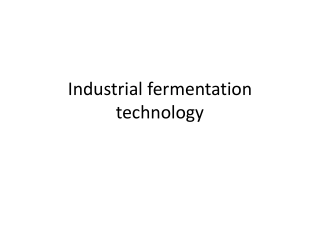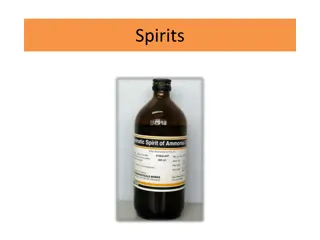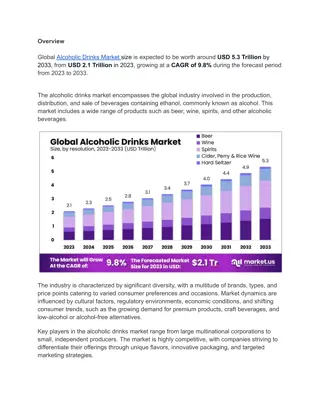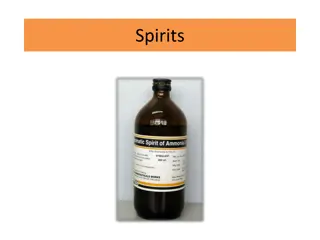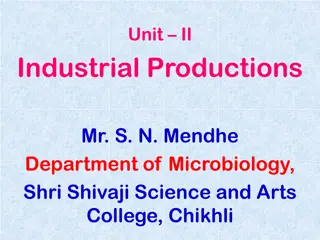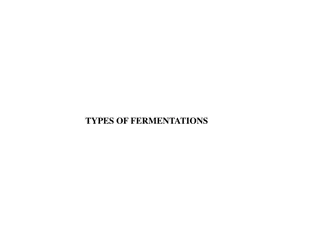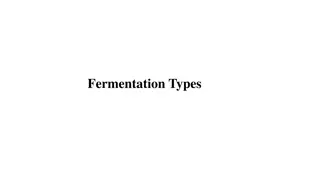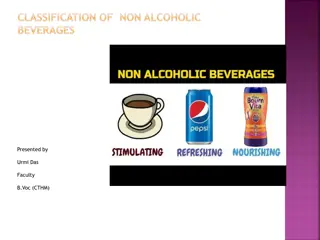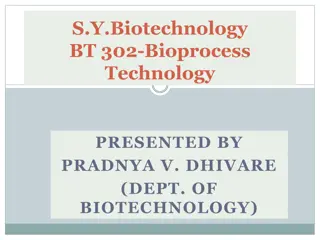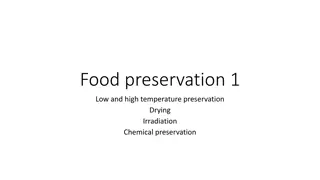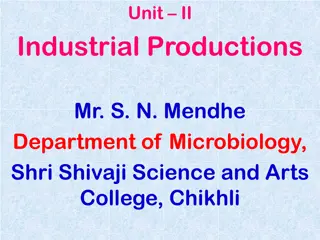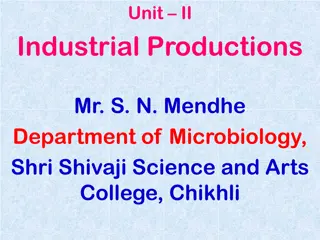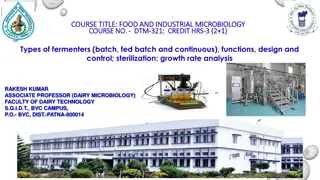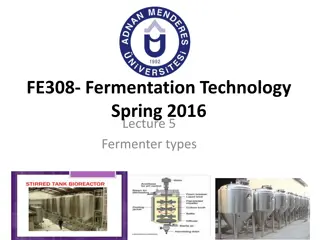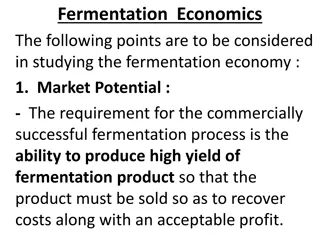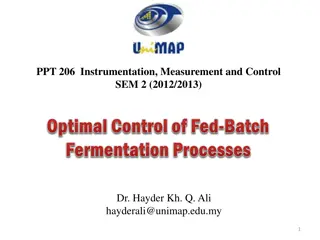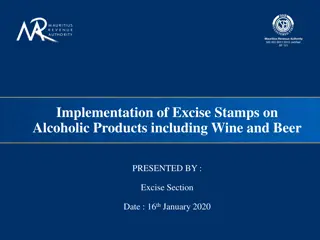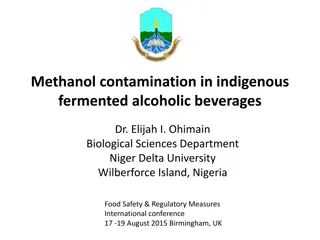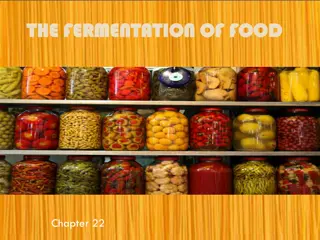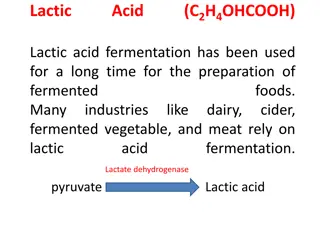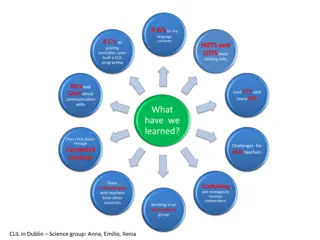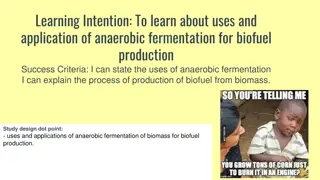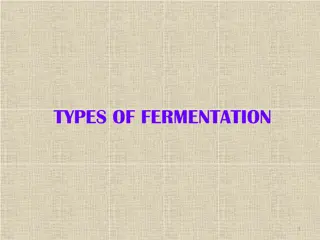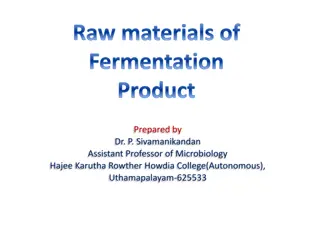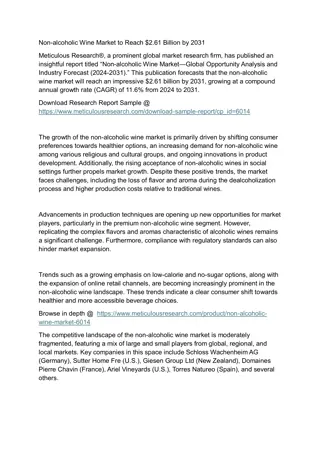Respiration
The definition and role of aerobic respiration, the overall sequence of reactions for glucose, and the two-stage process. Explore the concepts of anaerobic respiration and fermentation, including the role of microorganisms in industrial fermentation. Discover the cellular location of each stage and
0 views • 11 slides
Understanding Steatotic Liver Disease: Importance, Epidemiology, and Pathology
Steatotic liver disease, including metabolic dysfunction associated steatohepatitis (MASLD) and metabolic associated alcoholic liver disease (MALD), is a common cause of liver test abnormalities in the United States. Risk factors such as obesity and metabolic syndrome can lead to advanced fibrosis a
2 views • 44 slides
Industrial fermentation technology
Industrial fermentation technology involves three key stages - Up-Stream Processing (USP), the fermentation process, and Down-Stream Processing (DSP). USP includes formulating the fermentation medium, sterilization, inoculum preparation, and improving desired microorganisms for increased productivit
1 views • 23 slides
Precision Fermentation in Sustainable Food Production
Precision Fermentation is a specialized bioprocessing technique that utilizes microbes as cell factories to produce specific functional ingredients like proteins, vitamins, enzymes, and more. This innovative technology addresses the challenges of increasing food demands in a sustainable way, offerin
1 views • 12 slides
Understanding Spirits and Their Uses in Therapeutics and Flavoring
Spirits, also known as essences, are alcoholic or hydro-alcoholic solutions containing volatile substances. They can be classified based on therapeutic or flavoring purposes. These solutions are prepared by distillation or dissolving volatile substances in alcohol, with varying alcohol content. Spir
4 views • 17 slides
Our Beautiful Stinky Friends
Delve into the fascinating world of fermentation with chef/scientist David Zilber in this insightful listening guide based on the Science Friday podcast. Explore the science, ingredients, and techniques behind fermentation as Zilber shares his expertise and tips for home fermenters. Enhance your kno
0 views • 9 slides
Digital Retail Platforms Transform the Alcoholic Drinks Market
Global Alcoholic Drinks Market size is expected to be worth around USD 5.3 Trillion by 2033, from USD 2.1 Trillion in 2023, growing at a CAGR of 9.8%\n
2 views • 4 slides
Understanding Spirits: Types and Uses
Spirits are alcoholic or hydro-alcoholic solutions of volatile principles, mainly volatile oils, classified into therapeutic and flavoring types. They are prepared by distillation or dissolving volatile substances in alcohol, with varying alcohol content. Proper storage in light-resistant containers
1 views • 20 slides
Industrial Production of Ethyl Alcohol: Processes and Microorganisms
Ethyl alcohol production from molasses involves specific steps like selecting yeast strains, preparing inoculum, and creating fermentation conditions. Yeasts like Saccharomyces cerevisiae play a crucial role due to their alcohol tolerance and rapid growth properties. The process requires careful han
1 views • 23 slides
Industrial Production of Citric Acid and Microbial Fermentation
Industrial production of citric acid has evolved from extraction processes to microbial fermentation, offering various industrial applications. Citric acid is utilized as an acidulant in food and pharmaceutical industries, a chelating agent in tanning, and a flavor enhancer in carbonated beverages.
1 views • 18 slides
Understanding Different Types of Fermentations
Alcoholic fermentation involves the production of ethanol, commonly carried out by yeasts like Saccharomyces cerevisiae. On the other hand, lactic acid fermentation results in the production of lactic acid through two types: homo-fermentative and heterofermentative pathways. Different substrates and
2 views • 23 slides
Understanding Types and Benefits of Solid State Fermentation
Fermentation is a metabolic process involving enzymes transforming organic substrates. Solid state fermentation (SSF) is a method without free water, crucial for enzyme production using natural materials like grains and fruit pulps. This process is cost-effective, environmentally friendly, and easy
1 views • 15 slides
Exploring the Classification of Non-Alcoholic Beverages
Delve into the world of non-alcoholic beverages, ranging from aerated water to natural water, squashes, juices, syrups, coffee, tea, and milk-based drinks like chocolate malted drinks. This comprehensive classification sheds light on the diverse range of alcohol-free drinks available in the food ser
0 views • 6 slides
Understanding Bioprocess Technology and its Applications
Bioprocess technology involves utilizing living cells or their components like bacteria and enzymes to produce desired products through fermentation. This field covers a range of processes, including microbial bioprocesses, enzyme production, metabolite synthesis, recombinant products, and transform
0 views • 15 slides
Understanding Fermentation as a Food Preservation Technique
Fermentation is a natural process where microorganisms alter the sensory and functional properties of food to create a desirable end product. This method not only extends shelf life but also improves nutritional value, aids digestibility, and enhances food safety. Fermentation does not require expen
1 views • 31 slides
Industrial Production of Citric Acid: Fermentation Processes and Applications
Citric acid is industrially produced through microbial fermentation processes. It is widely used in various industries such as food, pharmaceuticals, and beverage production. Different methods like surface culture fermentation are employed for citric acid manufacture, with fungi like Aspergillus nig
4 views • 18 slides
Energy and Sports Drinks Dominate Non-Alcoholic Beverage Market Segments
Non-Alcoholic Beverages Market By Product (Bottled Water, Soft Drinks(Carbonated Soft Drinks, Non-Carbonated Soft Drinks, Energy & Sports Drinks), Juices(Orange Juice, Apple Juice, Grapefruit Juice, Pineapple Juice, Grape Juice and Others), Ready-to-
0 views • 4 slides
Understanding the Industrial Production of Vinegar
Vinegar fermentation, with its rich history and diverse classification based on raw materials, involves two essential fermentations - alcoholic fermentation and acetous fermentation. Various microorganisms, particularly Acetobacter species, play a crucial role in vinegar production. Different method
0 views • 15 slides
Industrial Production of Wines: Process and Classes
Wine production involves fermentation of grapes with variations in color, alcohol, and sugar content, resulting in different classes of wines like red, white, sweet, dry, sparkling. The process includes grape selection, fermentation, aging, and bottling to create high-quality wines.
3 views • 16 slides
Understanding Triple Sugar Iron Agar (TSI Agar) Test
Triple Sugar Iron Agar (TSI Agar) is a differential media used for identifying gram-negative enteric bacilli based on carbohydrate fermentation and hydrogen sulfide production. It helps detect carbohydrate fermentation, gas production, acidification, and H2S formation, providing valuable information
1 views • 28 slides
Understanding Fermentation and Bioreactors in Food and Industrial Microbiology
Fermentation is a crucial process where substances break down into simpler forms using organisms, generating energy. Bioreactors are systems supporting biochemically active environments for specific organisms, either aerobic or anaerobic. Learn about the history, importance, and applications of ferm
1 views • 16 slides
Understanding Fermenter Design and Functionality
The fermenter is essential in the fermentation process, providing a controlled environment for biomass and product yields. It enables aseptic fermentation, optimal mixing, and aeration without excessive power consumption. Key functions include temperature control, pH regulation, and minimizing evapo
1 views • 36 slides
Understanding Fermentation Economics: Key Market Considerations
Studying the fermentation economy involves assessing market potential, competition, cost recovery, and distribution strategies. Market demand, competition, production costs, and potential profits are crucial factors to consider for successful commercial fermentation processes. Foreign sales can offe
0 views • 19 slides
Principles of Fed-Batch Fermentation in Biotechnology
Explore the concept of fed-batch fermentation, a key technique in biotechnological processes. This method involves adding nutrients in controlled doses based on specific criteria to optimize cell growth and minimize undesirable metabolic pathways. Fed-batch systems allow for high cell densities and
0 views • 24 slides
Implementation of Excise Stamps on Alcoholic Products for Tax Administration
The implementation of excise stamps on alcoholic products, including beer and wine, is presented by the Excise Section. This initiative aims to combat tax evasion and smuggling by extending the obligation to affix tax stamps on bottles of beer and wine. The process involves using temporary excise st
0 views • 23 slides
Understanding Liniments: Alcoholic and Oleaginous Solutions for External Application
Liniments are topical solutions intended for external application to the skin through rubbing. They can be alcoholic or oleaginous, with the choice of vehicle depending on the desired action and solubility of components. Emulsions require thorough shaking before use, and the solvent for oleaginous l
4 views • 5 slides
Methanol Contamination in Indigenous Fermented Alcoholic Beverages: Impacts and Regulatory Measures
Indigenous fermented alcoholic beverages are facing methanol contamination issues, leading to severe health consequences and fatalities worldwide. This article highlights the concerning incidences of methanol poisoning, symptoms, and regulatory limits in various countries. The informal production of
13 views • 27 slides
The Fascinating World of Food Fermentation
Explore the rich history and benefits of fermentation, from the early nomads' discovery of cheese and yogurt to Louis Pasteur's groundbreaking work. Learn about the different types of respiration, microbial fermentation in food production, and the energy-releasing process of cell respiration. Discov
0 views • 13 slides
Lactic Acid Fermentation in Food Industry
Lactic acid fermentation is a widely used method for producing fermented foods like dairy, vegetables, and meats. This process involves lactic acid bacteria and filamentous fungi to convert sugars into lactic acid. Various microbial cultures are utilized, and raw materials such as whey, molasses, an
0 views • 23 slides
Medical Nutrition Therapy in Non-alcoholic Fatty Liver Disease
Medical Nutrition Therapy (MNT) plays a crucial role in managing Non-alcoholic Fatty Liver Disease (NAFLD), focusing on insulin resistance, metabolic syndrome, oxidative stress, dyslipidemia, and cardiovascular risk. Lifestyle recommendations include weight management and increasing physical activit
0 views • 36 slides
Pharmacotherapy for Non-Alcoholic Fatty Liver Disease: An Updated Review by Anita Eftekharzadeh
This comprehensive review discusses the pharmacotherapy options for Non-Alcoholic Fatty Liver Disease (NAFLD), covering topics such as sub-classification of NAFLD, proposed risk stratification, non-invasive measures for assessing liver fibrosis, and the NAFLD Activity Score (NAS). Anita Eftekharzade
0 views • 44 slides
Applications and Industrial Production of Fermentation in Various Sectors
Fermentation plays a crucial role in the production of organic solvents, food products, condiments, dairy products, processed meats, beverages, vitamins, and pharmaceutical compounds like antibiotics and vaccines. Specific examples include the production of citric acid, lactic acid, monosodium gluta
0 views • 6 slides
Exploring Alcoholic Fermentation Using Yeast in CLIL Science Lesson
This CLIL lesson focuses on the process of alcoholic fermentation using yeast in brewing, baking, winemaking, and cider production. Students will learn about metabolism, biotechnology applications, and different cultures in Europe. The lesson includes activities to build understanding through hands-
0 views • 4 slides
Managing Abnormal Liver Function Tests in Primary Care: Summary Guideline
Guideline drafted by Dr. Sally Hull and Dr. Lucy Carter focuses on identifying patients at risk of chronic liver disease, increasing testing for treatable liver conditions, and auditing prevalence of major liver diseases. The importance of diagnosing Non-Alcoholic Fatty Liver Disease (NAFLD) and str
0 views • 23 slides
Liver Disease Burden in Tower Hamlets
Dr. Somen Banerjee, Director of Public Health in London Borough Tower Hamlets, highlights the concerning liver disease mortality rates in the area, with high incidence of cirrhosis, cancer, and hepatitis B and C. The data reveals a significant burden of liver diseases such as Non-Alcoholic Fatty Liv
0 views • 18 slides
Understanding Cellular Respiration and Fermentation Processes
Cellular respiration is the energy-releasing process in which organisms take in glucose and oxygen to produce carbon dioxide, water, and energy. This process is vital for all living organisms. Photosynthesis and respiration are opposite processes, with respiration requiring the products of photosynt
0 views • 10 slides
Anaerobic Fermentation for Biofuel Production: Uses and Applications
Anaerobic fermentation is a key process converting biomass into biogas without oxygen. Biofuels, such as bioethanol and biodiesel, derived from biomass like agricultural and industrial waste, offer renewable and environmentally friendly energy alternatives. The applications of anaerobic fermentation
0 views • 11 slides
Overview of Different Types of Fermentation Processes
Explore the various types of fermentation processes including batch fermentation, fed-batch fermentation, continuous fermentation, solid-state fermentation, anaerobic fermentation, and aerobic fermentation. Each process has its own advantages and disadvantages, influencing factors such as sterilizat
0 views • 18 slides
Raw Materials in Industrial Fermentation Processes
Microorganisms utilized in industrial fermentation require essential raw materials such as water, energy sources, carbon, nitrogen, mineral elements, and sometimes vitamins and oxygen. Various raw materials like cane molasses, beet molasses, cereal grains, starch, glucose, and lactose serve as carbo
0 views • 15 slides
Non-alcoholic Wine Market
Non-alcoholic Wine Market Size, Share, Forecast, & Trends Analysis by Product (Sparkling, Still), Source (Grape), Technology (Dealcoholization), Packaging (Bottle, Can), Distribution Channel (Supermarkets, Online Stores, QSR)\u2014Global Forecast to
0 views • 2 slides


